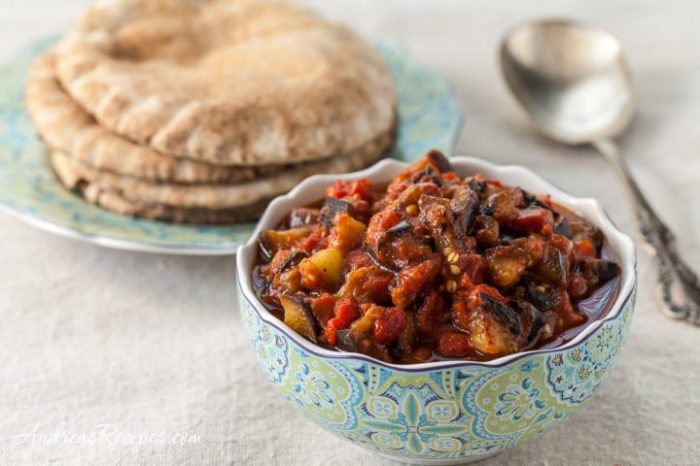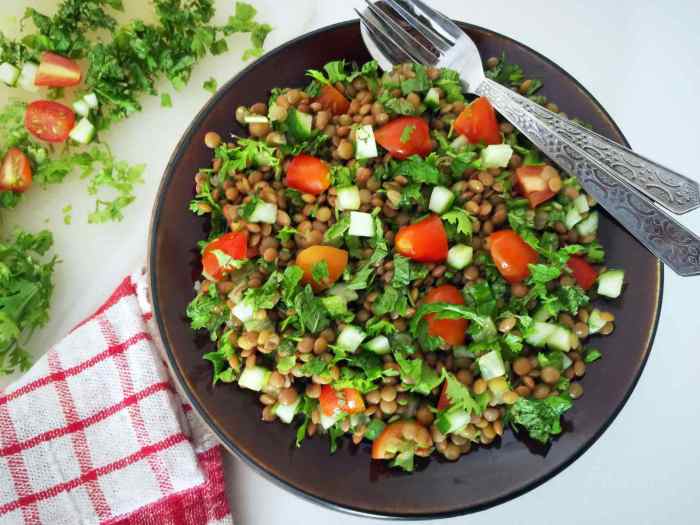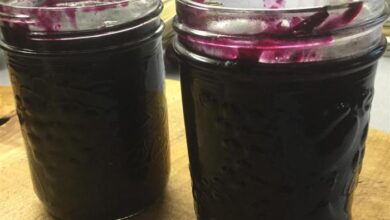
Middle Eastern Tomato Salad: A Flavorful Journey
Middle Eastern tomato salad is more than just a simple dish; it’s a vibrant reflection of the region’s rich culinary heritage. This salad, often served as a refreshing accompaniment to hearty meals, is a testament to the region’s love for fresh ingredients and bold flavors.
From the sun-kissed tomatoes to the aromatic herbs, each element plays a crucial role in creating a symphony of taste that’s both familiar and exotic.
The variations in ingredients and preparation methods across the Middle East are a testament to the region’s diverse culinary landscape. While some recipes call for a simple combination of tomatoes, onions, and herbs, others incorporate more complex flavor profiles with the addition of spices, citrus fruits, and even dried fruits.
This adaptability allows for a personalized touch, making the salad a canvas for culinary creativity.
Introduction to Middle Eastern Tomato Salad

The Middle East has a rich culinary history, and tomato salad is a staple dish in many countries. It is a simple yet flavorful dish that showcases the region’s fresh ingredients and vibrant flavors. While the exact origins of tomato salad in the Middle East are unclear, it is believed to have emerged as tomatoes were introduced to the region in the 16th century.
Since then, the dish has evolved and adapted to local tastes and preferences, resulting in a diverse array of variations across the region.
Variations in Ingredients and Preparation Methods
The ingredients and preparation methods for tomato salad vary greatly across different regions of the Middle East. Some common ingredients include:
- Tomatoes: Ripe, juicy tomatoes are the star ingredient, with varieties like Roma, heirloom, or cherry tomatoes being commonly used.
- Onions: Red onions, white onions, or shallots are often added for their sharp flavor and aroma.
- Cucumber: Cucumbers add a refreshing and crunchy element to the salad.
- Herbs: Fresh herbs like parsley, mint, dill, and cilantro are frequently used to enhance the flavor profile.
- Lemon Juice: Lemon juice adds a tangy and acidic note to the salad, balancing the sweetness of the tomatoes.
- Olive Oil: High-quality olive oil is a key ingredient, providing richness and a distinct flavor.
- Salt and Pepper: These seasonings are used to enhance the flavors of the ingredients.
In addition to these basic ingredients, some variations of tomato salad may include:
- Sumac: A tangy and slightly sour spice that adds a unique flavor to the salad.
- Pomegranate Seeds: These offer a burst of sweetness and tartness, adding a delightful textural element.
- Feta Cheese: Crumbled feta cheese adds a salty and creamy flavor to the salad.
- Bread Crumbs: Some variations may include toasted bread crumbs for added texture and flavor.
The preparation methods also vary, with some recipes calling for chopped ingredients while others prefer diced or sliced tomatoes. Some salads are served chilled, while others are enjoyed at room temperature.
Key Ingredients and Their Role

A Middle Eastern tomato salad, bursting with vibrant flavors and textures, is a testament to the region’s culinary prowess. The key ingredients, carefully selected and combined, create a symphony of taste that tantalizes the palate.
The core ingredients, while seemingly simple, play a crucial role in shaping the salad’s unique character. They contribute not only to the taste and texture but also provide a range of nutritional benefits.
Tomatoes
The star of the show, tomatoes are the foundation of this salad. Ripe, juicy tomatoes, bursting with sweetness and acidity, are the ideal choice. The variety of tomatoes used can vary, but often, plump, red tomatoes like Roma or heirloom varieties are preferred.
These tomatoes provide a vibrant, fresh flavor that complements the other ingredients.
Onions, Middle eastern tomato salad
Onions, typically red or white, add a sharp, pungent note that balances the sweetness of the tomatoes. They can be diced, sliced, or thinly chopped, depending on the desired texture. The onions also contribute a unique aroma and enhance the overall flavor profile of the salad.
Cucumber
Cucumbers provide a refreshing crunch and a cool, slightly sweet flavor. They are usually sliced or diced, adding a welcome textural contrast to the soft tomatoes and onions. Cucumbers also contribute to the salad’s hydrating qualities.
Herbs
Fresh herbs, such as parsley, mint, dill, or cilantro, are essential for adding a burst of freshness and aroma. They enhance the flavor profile and create a vibrant, aromatic experience.
- Parsley, with its bright green color and slightly peppery flavor, is a classic addition, providing a refreshing and earthy note.
- Mint, known for its cool, invigorating flavor, adds a touch of sweetness and a cooling sensation, making it a perfect complement to the tangy tomatoes.
- Dill, with its delicate, anise-like flavor, provides a subtle complexity and adds a touch of elegance to the salad.
- Cilantro, with its unique, slightly citrusy flavor, adds a bright and pungent note that balances the sweetness of the tomatoes and the sharpness of the onions.
Lemon Juice
Lemon juice is the key to balancing the sweetness of the tomatoes and adding a bright, tangy flavor. It also helps to preserve the salad’s freshness and prevent oxidation.
Olive Oil
Extra virgin olive oil, known for its rich flavor and health benefits, adds a smooth, buttery texture and a subtle, fruity flavor to the salad. It also helps to enhance the flavor of the other ingredients.
Salt and Pepper
Salt and pepper are essential for seasoning the salad and enhancing the flavors of the other ingredients. They are used sparingly, just enough to bring out the natural flavors of the salad.
Traditional Preparation Methods
The classic Middle Eastern tomato salad is a testament to the region’s culinary heritage, showcasing fresh, vibrant ingredients and simple preparation techniques. It’s a dish that has been passed down through generations, with each family adding their own unique twist.
Preparing the Tomatoes
The key to a great Middle Eastern tomato salad lies in the quality of the tomatoes. Choose ripe, firm tomatoes with a deep red color. Wash them thoroughly and pat them dry. The tomatoes can be diced, chopped, or sliced, depending on personal preference.
For a more rustic salad, larger chunks of tomatoes are ideal, while a finer dice is preferred for a more refined presentation.
Preparing the Onions
Onions are an essential ingredient in Middle Eastern tomato salad, adding a sharp and tangy flavor. Traditionally, red onions are used, but white or yellow onions can also be substituted. The onions should be finely chopped, ensuring even distribution throughout the salad.
Preparing the Herbs
Fresh herbs are another key element in this salad. The most common herbs used are parsley, mint, and dill, each adding a unique flavor profile. The herbs should be finely chopped, allowing their flavors to infuse the salad.
Preparing the Dressing
The dressing is what brings all the flavors together. A classic Middle Eastern tomato salad dressing is made with olive oil, lemon juice, salt, and black pepper. Some recipes also include a pinch of sugar to balance the acidity of the lemon juice.
The dressing should be whisked together until emulsified, creating a smooth and flavorful sauce.
Assembling the Salad
Once all the ingredients are prepared, the salad can be assembled. The tomatoes, onions, and herbs are combined in a large bowl. The dressing is then poured over the salad and tossed gently to coat all the ingredients.
The salad should be chilled for at least 30 minutes before serving, allowing the flavors to meld.
Serving Suggestions and Accompaniments: Middle Eastern Tomato Salad

The beauty of Middle Eastern tomato salad lies in its versatility. It can be enjoyed as a refreshing side dish, a vibrant topping for various meals, or even as a standalone appetizer. The salad’s tangy and juicy flavors pair well with a wide range of dishes, enhancing the overall dining experience.
Serving Suggestions and Accompanying Dishes
This salad is typically served as a side dish alongside grilled meats, kebabs, falafel, hummus, and various Middle Eastern breads. Its bright acidity balances the richness of these dishes, creating a harmonious combination of flavors.






